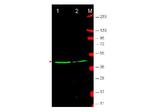Search Thermo Fisher Scientific
FIGURE: 1 / 1
Wnt1 Antibody (600-401-A37) in WB

Product Details
600-401-A37
Species Reactivity
Host/Isotype
Class
Type
Immunogen
Conjugate
Form
Concentration
Purification
Storage buffer
Contains
Storage conditions
Shipping conditions
Product Specific Information
Store vial at -20° C prior to opening. Aliquot contents and freeze at -20° C or below for extended storage. Avoid cycles of freezing and thawing. Centrifuge product if not completely clear after standing at room temperature. This product is stable for several weeks at 4° C as an undiluted liquid. Dilute only prior to immediate use.
This antibody reacts with human and mouse Wnt1 protein. A BLAST analysis was used to suggest cross-reactivity with Wnt1 from mouse, human, rat, bovine, dog, macaque, and opossum based on a 100% homology with the immunizing sequence. Partial cross-reactivity is expected against chicken Wnt1 based on a 91% sequence homology. Cross-reactivity with Wnt1 from other sources has not been determined.
Target Information
Wnt proteins constitute a family of secreted glyocoproteins that activate signal transduction pathways to mediate tissue homeostasis, cell fate, cell proliferation, and self-renewal. The canonical signaling pathway is initiated upon Wnt binding to a Frizzled family receptor and an LRP5/LRP6 coreceptor, which leads to activation of the beta-catenin cascade. Non-canonical Wnt signals are activated by binding to a Frizzled family receptor and ROR2 coreceptor. Extensive research has shown that deregulation of these pathways or its components can lead to cancer. Human Wnt-1 is encoded as a 370 amino acid precursor that, upon secretion, is cleaved into a 343 amino acid (42 kDa) mature form. At the amino acid level, mature human Wnt-1 is approximately 99% identical to mature mouse Wnt-1. Depending on the tissue, Wnt-1 can activate the canonical and non-canonical signaling pathways. Studies have demonstrated its involvement in a variety of functions, including embryonic development and carcinogenesis. Wnt-1 signaling can also induce the phosphorylation and subsequent degradation of c-Myb.
For Research Use Only. Not for use in diagnostic procedures. Not for resale without express authorization.
References (0)
Bioinformatics
Protein Aliases: murine mammary tumor virus integration site; Proto-oncogene Int-1; Proto-oncogene Int-1 homolog; proto-oncogene protein Wnt-1; Proto-oncogene Wnt-1; wingless-related MMTV integration site 1; Wingless-type MMTV integration site 1 homolog; Wingless-type MMTV integration site 1, homolog; wingless-type MMTV integration site family member 1; wingless-type MMTV integration site family, member 1; wingless-type MMTV integration site family, member 1 (oncogene INT1)
Gene Aliases: BMND16; Int-1; INT1; OI15; sw; swaying; Wnt-1; WNT1
UniProt ID: (Human) P04628, (Mouse) P04426
Entrez Gene ID: (Human) 7471, (Dog) 486560, (Rhesus monkey) 709009, (Bovine) 540662, (Rat) 24881, (Mouse) 22408

Performance Guarantee
If an Invitrogen™ antibody doesn't perform as described on our website or datasheet,we'll replace the product at no cost to you, or provide you with a credit for a future purchase.*
Learn more
We're here to help
Get expert recommendations for common problems or connect directly with an on staff expert for technical assistance related to applications, equipment and general product use.
Contact tech support
